

The Origin of the Universe - Stephen Hawking. The Origin of the Universe This lecture is the intellectual property of Professor S.W.Hawking.
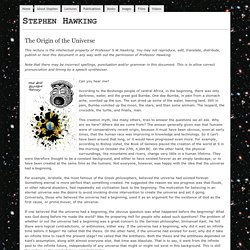
You may not reproduce, edit, translate, distribute, publish or host this document in any way with out the permission of Professor Hawking.Note that there may be incorrect spellings, punctuation and/or grammar in this document. This is to allow correct pronunciation and timing by a speech synthesiser. Can you hear me? Is Our Universe Part Of A Multiverse? - Documentary Lecture. How the universe has cooled since the Big Bang fits Big Bang theory. Astronomers using a CSIRO radio telescope have taken the Universe's temperature, and have found that it has cooled down just the way the Big Bang theory predicts.
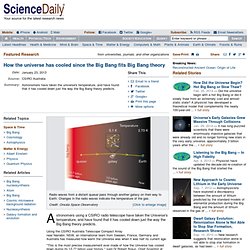
Using the CSIRO Australia Telescope Compact Array near Narrabri, NSW, an international team from Sweden, France, Germany and Australia has measured how warm the Universe was when it was half its current age. "This is the most precise measurement ever made of how the Universe has cooled down during its 13.77 billion year history," said Dr Robert Braun, Chief Scientist at CSIRO Astronomy and Space Science. Because light takes time to travel, when we look out into space we see the Universe as it was in the past -- as it was when light left the galaxies we are looking at. So to look back half-way into the Universe's history, we need to look half-way across the Universe. How can we measure a temperature at such a great distance? The astronomers studied gas in an unnamed galaxy 7.2 billion light-years away [a redshift of 0.89].
Astronomers Probe Our Cosmic Origins. "While there are likely hundreds of millions of quasars in the universe, there are only a handful you can use for a study like this," said Shull.
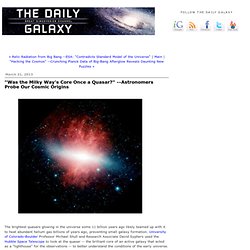
Quasars are nuclei in the center of active galaxies that have "gone haywire" because of supermassive black holes that gorged themselves in the cores, he said. "For our purposes, they are just a really bright background light that allows us to see to the edge of the universe, like a headlight shining through fog. " During a time known as the "helium reionization era" some 11 billion years ago, blasts of ionizing radiation from black holes believed to be seated in the cores of quasars stripped electrons from primeval helium atoms, said Shull. New Algorithm Allows Astronomers to Track the Process of Star Formation in the Early Universe. From top left to bottom right: number density of hydrogen nuclei, temperature, H2 fraction and free-fall time over sound-crossing time in a cube of side length 200 au, weighted with the mass and the square of the density of the cells traversed along the line of sight.
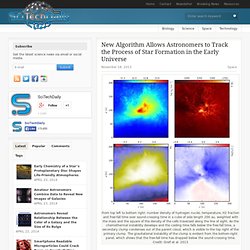
As the chemothermal instability develops and the cooling time falls below the free-fall time, a secondary clump condenses out of the parent cloud, which is visible to the top right of the primary clump. The gravitational instability of the clump is evident from the bottom-right panel, which shows that the free-fall time has dropped below the sound-crossing time. Credit: Greif et al. 2013 Astronomers have developed a new computational algorithm that allows them to follow the star formation process down to the very small scales, tracking development of filamentary substructures and secondary clumps as wide as only a few tens of astronomical units. The first stars have yet to be directly observed. Publication: Thomas H. Big Bang Theory, Expanding & Accelerating Universe. By Denise Chow, SPACE.com Staff Writer | October 18, 2011 05:00pm ET Credit: Subaru/ P.
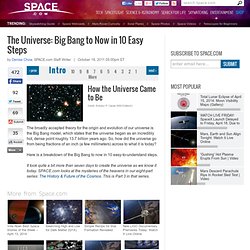
Capak (SSC/Caltech)The broadly accepted theory for the origin and evolution of our universe is the Big Bang model, which states that the universe began as an incredibly hot, dense point roughly 13.7 billion years ago. So, how did the universe go from being fractions of an inch (a few millimeters) across to what it is today?
Here is a breakdown of the Big Bang to now in 10 easy-to-understand steps. It took quite a bit more than seven days to create the universe as we know it today. Denise Chow Denise was an intern at the New York Daily News and GQ magazine. Denise Chow on. "A Galaxy So Ancient It Shouldn't Exist" Astronomers using the Herschel Space Telescope discovered a distant galaxy that challenges the current theories of galaxy evolution.
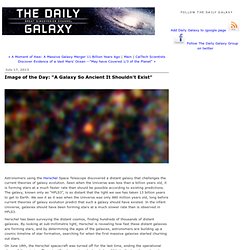
Seen when the Universe was less than a billion years old, it is forming stars at a much faster rate than should be possible according to existing predictions. The galaxy, known only as “HFLS3”, is so distant that the light we see has taken 13 billion years to get to Earth. We see it as it was when the Universe was only 880 million years old, long before current theories of galaxy evolution predict that such a galaxy should have existed. In the infant Universe, galaxies should have been forming stars at a much slower rate than is observed in HFLS3.
Controversial Study Suggests Our Universe is One of Many. The sky holds many wonders, such as stars, galaxies, supernovas, neutron stars and black holes, but now scientists claim it could hold something potentially more extraordinary — hints of an earlier universe, or even other universes.

However, a number of other researchers dispute these findings as evidence for past and other universes, suggesting that it could be easy to see something that isn't there in the data. Planck Space Telescope Shuts Down, Ending Mission To Observe Early Universe. After hunting for the earliest clues about the evolution of the universe for more than four years, Europe's Planck Space Observatory has gone dark.
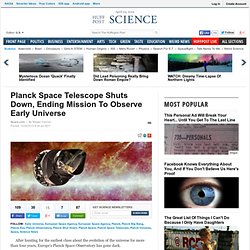
Officials with the European Space Agency sent the Planck observatory its final command on Wednesday (Oct. 23), marking the end of its prolific mission. The space observatory launched in May 2009 on a mission to scandeep space for the faint relic radiation called cosmic microwave background — the oldest light in the universe — created 380,000 years after the Big Bang. ESA officials described the Planck observatory as a sort of cosmic "time machine" because of its ability to peer back into the universe's history.
They sent the final command to Planck at 12:10:27 GMT (8:10:27 a.m. EDT) on Wednesday. Project scientist Jan Tauber sent the final command to the Planck space telescope from ESA's European Space Operations Center in Darmstadt, Germany, on Oct. 23, 2013. Subatomic calculations indicate finite lifespan for universe. Cosmic preheating baked planets, stars and people - space - 19 June 2013. TO COOK up planets, stars and people, the universe had to be preheated.
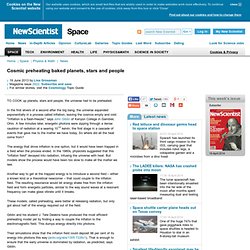
In the first slivers of a second after the big bang, the universe expanded exponentially in a process called inflation, leaving the cosmos empty and cold. "Inflation is a flash-freezer," says John Giblin of Kenyon College in Gambier, Ohio. A few minutes later, energetic photons were zipping through a dense cauldron of radiation at a searing 1010 kelvin, the first stage in a cascade of events that gave rise to the matter we have today. So where did all the heat come from? The energy that drove inflation is one option, but it would have been trapped in a field when the process ended. Another way to get at the trapped energy is to introduce a second field – either a known kind or a theoretical newcomer – that could couple to the inflaton field.
Our Lopsided Universe is Darker, Lighter, Slower, Older & More Mysterious than We Thought. Space-time ripples hint at physics beyond the big bang - space - 25 March 2014. Read full article Continue reading page |1|2 Slivers of a second after the universe was born, it ballooned exponentially in the blink of an eye.

This vision of cosmic expansion, called inflation, got a big boost last week with the announcement of the first sighting of primordial gravitational waves, ripples in space-time linked to the universe's rapid growth spurt. The findings – reported by the team that ran the BICEP2 experiment at the South Pole – are already helping physicists sort through the mountain of theories for how inflation happened (see our video of gravitational waves explained with a towel and apple). But there are a few wrinkles, including the fact that hints of the waves seem much more pronounced than they should be, according to previous observations of the early universe.
"Everyone was celebrating and so forth, but you have to be careful with this result," says Avi Loeb at the Harvard-Smithsonian Center for Astrophysics. Inflation's particle "How do we reconcile them? "